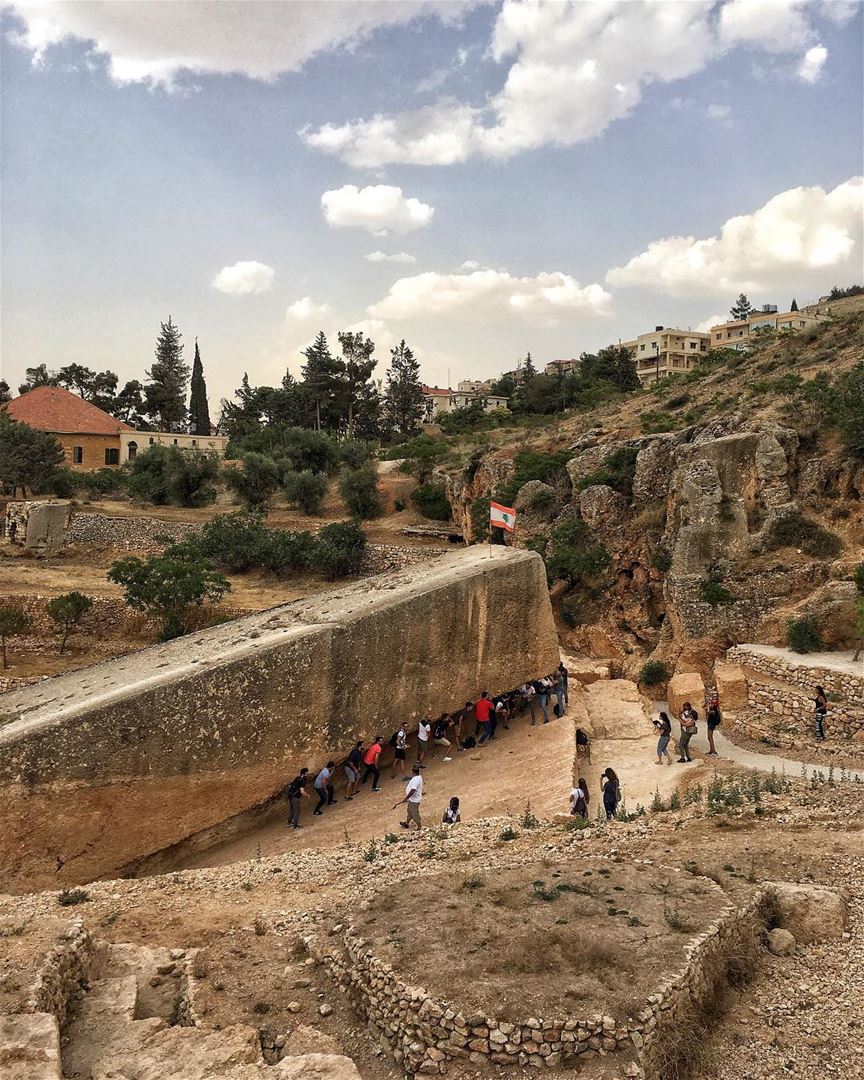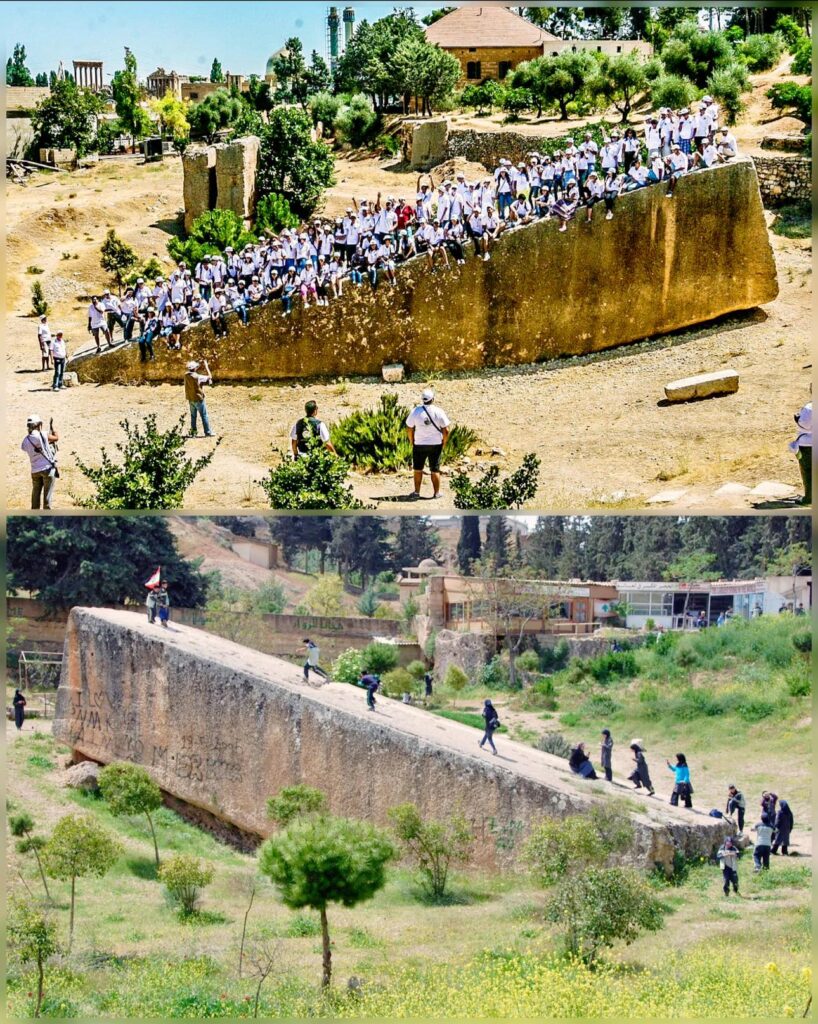The Stone of the Pregnant Woman, located in Baalbek, Lebanon, is the largest stone ever quarried by human hands. This incredible monolith, believed to have been extracted in the first century B.C., remains partially buried in the ancient quarries of Baalbek, leaving many to wonder how ancient builders managed such a feat. Standing as a symbol of the astonishing engineering capabilities of ancient civilizations, this stone has intrigued archaeologists, historians, and visitors for centuries.
Dimensions of a Colossal Monolith
The Stone of the Pregnant Woman measures an astounding 21.5 meters (70.5 feet) in length, 4.8 meters (15.75 feet) in width, and 4.2 meters (13.8 feet) in height. Weighing between 1,000 and 1,200 tons, it is a marvel in both size and craftsmanship. Despite its impressive dimensions, the stone was never fully extracted and remains embedded in the ground, highlighting the magnitude of the effort it would have taken to move such a gigantic structure.
![r/ancientrome - Baalbek, Lebanon, has one of the largest Roman buildings I have seen. Both in its individual blocks and in its cumulative structure. However, not far away in a quarry is this 1,000 ton Roman monolith [OC] that never made it into the temple. There are even two larger monoliths too…](https://preview.redd.it/ofjv646o29o11.jpg?width=640&crop=smart&auto=webp&s=fdaeb4abbe136d0ff53b7ee115d9e7d00fad8c18)
The Name and Mythology Behind It
The name “Stone of the Pregnant Woman” is tied to local folklore. One popular story suggests that the monolith’s name refers to the belief that a pregnant woman could lift the stone if given the right incentive. Another tale claims that the stone was named after a pregnant woman who promised to reveal the secret of how to move it if she were allowed to eat as much as she liked. While these stories are fanciful, they reflect the awe and mystery the stone has evoked for centuries.
Engineering Capabilities of Ancient Builders
The stone’s enormous size raises many questions about the capabilities of ancient engineers. How did they manage to extract such a large block with the limited technology available at the time? Researchers believe that ancient builders used a combination of levers, wooden rollers, and manpower to transport massive stones from the quarry to construction sites. However, with the Stone of the Pregnant Woman weighing over 1,000 tons, it is clear that this particular stone posed extraordinary challenges.
Further evidence of the ancient builders’ expertise can be found in the Temple of Jupiter in Baalbek, where several other massive stones, known as trilithon blocks, were successfully transported and placed. Each of these stones weighs around 800 tons, and they were moved nearly 1 kilometer from the quarry to the temple site. This achievement speaks volumes about the ancient world’s mastery of mechanics and construction techniques.

Recent Discoveries: The Even Larger Stone
In recent years, excavations at Baalbek’s quarry have revealed an even larger monolith buried beneath the Stone of the Pregnant Woman. This newly discovered stone weighs an estimated 1,650 tons, making it the largest known quarried stone in the world. The discovery has reignited interest in Baalbek’s engineering legacy and raised further questions about how these stones were meant to be moved and used.
Theories and Purpose of the Stone
The exact purpose of the Stone of the Pregnant Woman remains a subject of debate. Some researchers believe the stone, along with other massive blocks from the quarry, was intended for use in the construction of the Temple of Jupiter, one of the largest Roman temple complexes in antiquity. These stones may have been part of a ceremonial platform or foundation, designed to elevate the temple and enhance its grandeur.
Other theories suggest that the stone was abandoned due to difficulties in transportation, or perhaps because the intended construction project was never completed. Without definitive answers, the stone remains a symbol of unfulfilled ambition and the limits of even the most advanced ancient technology.

The Mystery Endures
While modern archaeologists have uncovered much about the methods and purposes behind Baalbek’s ancient stones, many mysteries still surround the Stone of the Pregnant Woman. Why was it left unfinished in the quarry? What motivated the construction of such enormous stones, and how did ancient builders intend to move them?
As political instability in the region has limited further exploration, the stone continues to captivate the imaginations of those who visit Baalbek. Its sheer size and the marvels of its engineering make it an enduring symbol of human ingenuity, ambition, and the mysteries of the ancient world.
Conclusion
The Stone of the Pregnant Woman is not just an archaeological artifact; it is a testament to the incredible engineering prowess of ancient civilizations. As one of the largest stones ever quarried, it speaks to the ambition, skill, and vision of the builders of Baalbek. While the full story of how and why this stone was created may never be known, its presence remains a powerful reminder of what ancient civilizations were capable of, and the mysteries that still surround their achievements.

